Zither (/ˈzɪðər,
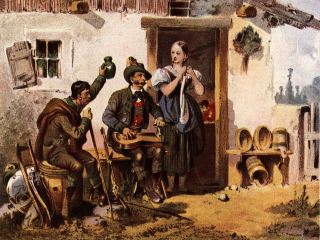
Zithers are played by strumming or plucking the strings, either with the fingers (sometimes using an accessory called a plectrum or pick), sounding the strings with a bow, or, with varieties of the instrument like the santur or cimbalom, by beating the strings with specially shaped hammers. Like a guitar or lute, a zither's body serves as a resonating chamber (sound box), but, unlike guitars and lutes, a zither lacks a distinctly separate neck assembly. The number of strings varies, from one to more than fifty.
In modern common usage the term "zither" refers to three specific instruments: the concert zither (German: Konzertzither), its variant the Alpine zither (both using a fretted fingerboard), and the chord zither (more recently described as a fretless zither or "guitar zither"). Concert and Alpine zithers are traditionally found in Slovenia, Austria, Hungary, France, north-western Croatia, the southern regions of Germany, alpine Europe, Poland, the Czech Republic, Slovakia, Russia, Ukraine and Belarus. Emigration from these areas during the 19th century introduced the concert and Alpine zither to North and South America. Chord zithers similar to the instrument in the photograph also became popular in North America during the late 19th and early 20th century. These variants all use metal strings, similar to the cittern.
The word 'zither' is derived from Latin cythara, which was used in this form for the title covers on many 16th and 17th century German printed manuscript books originally for the 'cittern' – from the Greek word kithara, an instrument used in Ancient Greece. The German scholar Michael Praetorius mentions an Englishman who came to Germany with a small cittern, einem kleinen Citterlein, in his treatise Syntagma Musicum, published during the early 17th century. It is not fully understood how 'zitter' or 'zither' came to be applied to the instruments in this article as well as German varieties of the cittern. Other types of zither also existed in Germany, mostly drone zithers like the scheitholt (which was mentioned by Praetorius) or hummel, but these generally have their own individual regional names and may have been in use before the introduction into the lexicon of 'cythara' and its German derivative cognate.
The Hornbostel-Sachs system, an academic instrument classification method, also uses the term zither to classify all stringed instruments in which the strings do not extend beyond the sounding box. This includes such diverse instruments as the hammered dulcimer, psaltery, Appalachian dulcimer, guqin, guzheng, tromba marina, koto, gusli, kanun, kanklės, kantele, kokles, valiha, gayageum, đàn tranh, autoharp, santoor, yangqin, santur, swarmandal, and others. Pedal steel guitars, lap guitars (where the neck serves no separate function other than to extend the string length), and keyboard instruments like the clavichord, harpsichord and piano also fall within this broad categorical use.
The word has also been used in conjunction with brand varieties of other string instruments, for example the zither banjo.
The earliest known surviving instrument of the zither family is a Chinese guqin, a fretless instrument, found in the tomb of Marquis Yi of Zeng dating from 433 BC. Similar instruments along this design were developed over the following centuries, for example: the Japanese silk strung koto, the siter of Indonesian gamelans; the Qānūn (or Kanun) of the Middle East; the valiha, a tube zither of Madagascar; and many others. Increasing interest in 'world music' has brought wider recognition to these other zither family members, both ancient and modern. Many of these instruments have been sampled electronically, and are available in instrument banks for music synthesizers.

In Europe and other more northern and western regions, early zithers were more similar to the modern mountain dulcimer, having long, usually rectangular, sound boxes, with one or more melody strings and several unfretted drone strings. Some of these employed movable bridges similar to the Japanese koto, used for retuning the drone strings. The Alpine Scheitholt furnishes an example of this older type of European zither. By the late 18th century, two principal varieties of European concert zither had developed, known as the Salzburg zither (with a rounded side away from the player), and the Mittenwald zither (with both sides rounded). Both styles are still found in concert zithers today, although the Salzburg style has become by far the most common.
The zither became a popular folk music instrument in Bavaria and Austria and, at the beginning of the 19th century, was known as a Volkszither.
Viennese zitherist Johann Petzmayer (1803–1884) became one of the outstanding virtuosi on these early instruments, and is credited with making the zither a household instrument. In 1838, Nikolaus Weigel of Munich conceived the idea of adopting fixed bridges, adding additional strings, tuning them in the cycle of fifths, and chromatically fretting the fingerboard – effectively converting a rather crude folk instrument into the concert zither. His ideas were not, however, widely accepted until 1862, when luthier Max Amberger of Munich fabricated a new zither based on Weigel's design. At this point the zither had reached something very close to its modern concert form. Within a relatively short time the new design had largely replaced the old Volkszither (though still called by the same name among folk musicians) throughout central Europe, particularly in the Alpine countries. As the 'concert zither' it also began to attract the attention of serious composers, a number of whom, themselves, became concert zither virtuosi. These composers, called the "Altmeister", flourished between 1870 and 1910. And no less a composer than Johann Strauss II gave the instrument a prominent solo in one of his most famous waltzes, "Tales from the Vienna Woods".
The zither went through two periods of great popularity in the United States. The first of these was in the late 19th through early 20th century, when it was greatly in vogue as a parlour instrument in many homes. During that period, a number of U.S.-based instrument manufacturers, many of them founded by, or staffed with, European (and especially German and Austrian) luthiers, were producing concert zithers. Chord zithers were often marketed under confusing brand names like 'guitar zither' or 'mandoline zither'. The recently rediscovered recordings of the gospel singer Washington Phillips, who used two instruments simultaneously, have revealed the virtuosic capability of the chord zither to modern musicians seeking to revive it. By the 1920s, this popularity had begun to wane, as other string instruments (notably guitars) increased in popularity along with the new fashion for jazz music.
In the 1950s, interest in zithers resurfaced due in great measure to the success of the 1949 British film noir The Third Man. The soundtrack music for the film, which featured only a concert zither (no other instruments) – was performed by the Viennese musician Anton Karas. His "The Third Man Theme" was released as a single in 1949–50 and became a best-seller in the UK. Following its release in the U.S. in 1950, it spent eleven weeks at number one on Billboard's U.S. Best Sellers in Stores Chart from 29 April to 8 July. The exposure made Karas an international star. A Time magazine film preview stated that "the famous musical score by Anton Karas" would have the audience "in a dither with his zither".
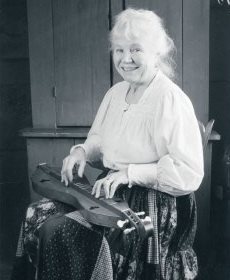
This new popularity for the zither lasted until well into the 1960s with many successful albums during the period from performers such as Karas, Ruth Welcome, and Shirley Abicair. German-born American Ruth Welcome released a number of very popular theme-based zither albums between 1958 and 1965 (e.g., Romantic Zither; Zither South of the Border; Zither Goes to Hollywood). Australian-born singer Shirley Abicair popularised the chord zither when she used it for accompaniment in her TV shows, live performances and recordings in Britain in the 1950s and '60s. Zither music also featured in a Twilight Zone episode – Mr Bevis in 1960.
A concert zither may have from 29 to 38 strings, with 34 or 35 being most typical. These are arranged as follows: four or five fretted melody strings, placed above a guitar-like fretboard; 12 unfretted "accompaniment" strings; followed by 12 unfretted "bass" strings; followed by a varying number of "contrabass" strings, with five or six being the most common number.
On some older zithers, one may find "half-frets" above the 12th fret, which extend only under the first two or three strings. This results in the lower fretted strings having no pitches (or no chromatic pitches) available above the 12th fret, while the higher fretted strings still have higher chromatic pitches available at these half-frets. Nearly all instruments made after 1960, however, have full-length frets all the way up the fretboard.
Anton Karas and Ruth Welcome used instruments of similar design to the one illustrated. After World War II, Karas (according to zither scholar Günter Wittenstein, who was acquainted with him) performed on an instrument of larger dimensions than normal – with a 43 cm standard scale length for the fingerboard strings. He used Viennese tuning (see below), but with an altered chromatic sequence for the fingerboard and open strings. The accompaniment strings G and F♯ were tuned an octave higher, while contrabass strings tuned E♭, F, D, E, C♯ replaced the regular cycle of fifths bass strings. This brought the contrabasses closer to the fingerboard where the player could reach them more easily.
For The Third Man, Karas tuned the zither a semi-tone lower, giving a particularly distinctive tone to the contrabass strings. The resulting lower string tension also enabled Karas to perform an expressive vibrato on the fingerboard melody strings. Film director Carol Reed, (on whose oak kitchen table the music was performed), described the sound as "gritty and dirty", perfectly reflecting the atmospheric mood of the film.
The Alpine zither has 42 strings, and differs from the concert zither primarily in requiring the addition of an extension to the body of the instrument to support both the longer additional contrabass strings and their tuners.
Alpine zithers are tuned in a similar manner to the concert zither, with the accompaniment and bass strings each providing a full set of 12 chromatic pitches also arranged in a cycle of fifths. Contrabass strings are arranged in a descending chromatic scale. Late 19th and early 20th century versions of the instrument were often called 'harp zithers' – so-named because the pillar extension seemed a miniature version of the harp's pillar. The extra contrabass strings ran parallel to the other strings on these earlier instruments, the diagonal arrangement illustrated developed later to assist the right hand in reaching the strings.
There are two popular tunings for the modern zither: Munich and Viennese. The "zither tuning chart" below, gives tuning details, including pitches and octaves. Munich tuning is on top, and Vienna tuning below. Some players have used Vienna tuning only for the fretted strings, and Munich tuning for the unfretted strings. Full Viennese tuning is normally used only on instruments with 38 or fewer strings.
Tuning chart for concert and Alpine zithers:
| Zither tuning chart | |||||||||||||||||||||||||||||||||||||||||||
|---|---|---|---|---|---|---|---|---|---|---|---|---|---|---|---|---|---|---|---|---|---|---|---|---|---|---|---|---|---|---|---|---|---|---|---|---|---|---|---|---|---|---|---|
| Fretted | Unfretted | ||||||||||||||||||||||||||||||||||||||||||
| String | Melody | Accompaniment | Basses | Contrabasses | |||||||||||||||||||||||||||||||||||||||
| 1 | 2 | 3 | 4 | 5 | 6 | 7 | 8 | 9 | 10 | 11 | 12 | 13 | 14 | 15 | 16 | 17 | 18 | 19 | 20 | 21 | 22 | 23 | 24 | 25 | 26 | 27 | 28 | 29 | 30 | 31 | 32 | 33 | 34 | 35 | 36 | 37 | 38 | 39 | 40 | 41 | 42 | ||
| Pitch | Munich | A4 | A4 | D4 | G3 | C3 | E♭4 | B♭3 | F4 | C4 | G3 | D4 | A3 | E4 | B3 | F♯3 | C♯4 | G♯3 | E♭3 | B♭2 | F3 | C3 | G2 | D3 | A2 | E3 | B2 | F♯2 | C♯3 | G♯2 | F2 | E2 | E♭2 | D2 | C♯2 | C2 | B1 | B♭1 | A1 | G♯1 | G1 | F♯1 | F1 |
| Viennese | A4 | D4 | G4 | G3 | C3 | A♭4 | E♭4 | B♭3 | F4 | C4 | G4 | D4 | A3 | E4 | B3 | F♯4 | C♯4 | G♯3 | E♭2 | B♭2 | F2 | C3 | G2 | D2 | A2 | E2 | B2 | F♯2 | C♯2 | G♯2 | C2 | B1 | B♭1 | A1 | G♯ | G1 | F♯1 | F1 | |||||
| Notes: | Basic | Concert | Alpine | ||||||||||||||||||||||||||||||||||||||||
The zither is played by plucking the strings while it lies flat on a table (which acts as a resonator to amplify the sound), or it can be held on the lap.
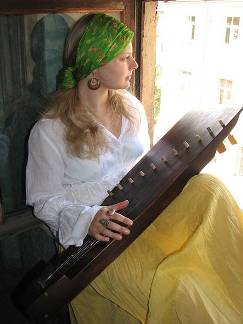
On concert and Alpine zithers the melody strings are pressed to the fingerboard ("fretted") with the fingers of the left hand, and plucked with a plectrum on the right thumb. First and second fingers of the right hand pluck the accompaniment and bass strings, and the third finger of the right hand plucks the contrabass strings (there are variants on this technique).
The concept of the chord zither is different from that of the concert and alpine zithers. These instruments may have from 12 to 50 (or more) strings, depending on design. All the strings are played open, in the manner of a harp. The strings on the left are arranged in groups of three or four, which form various chords to be played by the left hand. The strings to the right are single (or pairs of) strings intended for the right hand to pick out the melody. Tuning can vary widely from manufacturer to manufacturer and even from model to model, but is usually indicated on the instrument itself, in the form of a painted or paper chart glued under the strings.
Since the zither required advanced technique to play anything more than simple tunes, the vast majority of the concert zithers sold never attained more than amateur or (mostly) ornamental use; the playing of Washington Phillips was a rare exception.
As a result, manufacturers attempted to simplify the instrument with various keyboard devices attached to the melody strings (Marxophone, dolceola, celestaphone, tremoloa, etc.). The invention of the autoharp, which uses bars with felt pads attached underneath placed across and above the strings, is probably the most successful adaptation. However, the absence of a fretboard makes the autoharp a closer relative of the chord zither than the concert zither. Presence of the concert zither in classical music remains sparse.
Concert and Alpine zithers remain in use by a relatively small number of contemporary musicians from various global regions and musical genres, either out of interest in traditional musical styles for the instrument, or from a desire to seek new sounds for their music. New variations on the concert zither have also been employed, including the electric zither—and recent instruments that share zither characteristics, such as the Chapman stick.
While use of the concert zither itself has declined, zither music and technique continued to influence contemporary musicians. For example: Canadian musician Jeff Healey, featured in the film thriller Road House in 1989, used a zither technique to play electric guitar. Blind from the age of one, Healey began playing when he was three with the instrument flat on his lap, left hand above the fingerboard in the same manner as a zitherist. Although he used a Fender Stratocaster guitar throughout his career, the instrument was in effect being used as an electric zither.
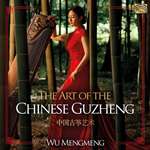
The zheng (Chinese: 箏; Wade–Giles: cheng) or guzheng (Chinese: 古箏; literally: 'ancient zheng'), also known as a Chinese zither, is a Chinese plucked string instrument with a more than 2,500-year history. The modern guzheng commonly has 21 strings, is 64 inches (1.6 m) long, and is tuned in a major pentatonic scale. It has a large, resonant soundboard made from Paulownia. Other components are often made from other woods for structural or decorative reasons. Guzheng players often wear fingerpicks made from materials such as plastic, resin, tortoiseshell, or ivory on one or both hands.
The guzheng is ancestral to several other Asian zithers such as the Japanese koto, the Korean gayageum, Mongolian yatga, and the Vietnamese đàn tranh. The guzheng should not be confused with the guqin, a Chinese zither with 7 strings played without moveable bridges.
The guzheng has gone through many changes during its long history. The oldest specimen yet discovered held 13 strings and was dated to around 500 BCE, possibly during the Warring States period (475–221 BCE). The guzheng became prominent during the Qin dynasty (221–206 BCE). By the Tang Dynasty (618–907 CE) the guzheng may have been the most commonly played instrument in China.
There are varied accounts for how the guzheng came to be. An early guzheng-like instrument is said to have been invented by Meng Tian, a general of the Qin dynasty (221-206 BCE), largely influenced by the se. Some believe the guzheng was originally developed as a bamboo-tube zither as recorded in the Shuowen Jiezi, which was later redesigned and made from larger curved wooden boards and movable bridges. A third legend says the guzheng came about when two people fought over a 25-string se. They broke it in half, one person receiving a 12-string part and another the 13-string part.
Strings were once made of silk. During the Qing dynasty (1644-1912 CE) the strings transitioned to bare wire such as brass. Modern strings are almost always steel coated in nylon. First introduced in the 1970s these multi-material strings increased the instrument's volume while maintaining an acceptable timbre.
The guzheng is often decorated. Artists create unique cultural and artistic content on the instrument. Decorations include carved art, carved lacquer, straw, mother-of-pearl inlays, painting, poetry, calligraphy, shell carving (jade) and cloisonné.
Playing styles are first divided between Northern and Southern before being further subdivided into specific regional schools. Regional schools that are part of the Northern style include Henan, Shaanxi, Shandong, and Zhejiang. Regional schools included in the Southern style include Chaozhou, Hakka, and Fujian.
Examples of Northern pieces include High Mountain and Running River and Autumn Moon over the Han Palace from the Shandong school. Southern style can be represented by Jackdaw Plays with Water (Han Ya Xi Shui) from the Chaozhou school and Lotus Emerging from Water (Chu shui lian) from the Hakka school.
Many pieces have been composed since the 1950s both with new techniques and mixing elements from the north and south, ultimately creating a new modern school.
The guzheng is plucked by the fingers with or without plectra. Most modern players use plectra that are attached to up to four fingers on each hand. Ancient picks were made of mundane materials such as bamboo, bone, and animal teeth or by finer materials such as ivory, tortoiseshell, and jade.
Traditional playing styles use the right hand to pluck notes and the left hand to add ornamentation such as pitch slides and vibrato by pressing the strings to the left of the movable bridges. Modern styles use both hands to play on the right side of the strings. There are many techniques used to strike notes. One iconic sound is a tremolo produced by the right thumb rotating rapidly around the same note.
New techniques include playing harmony and counterpoint with the left hand. Pieces in the new style include Harvest Celebration (Qing Feng Nian, Zhao Yuzhai, 1955), Fighting the Typhoon (Zhan Tai Feng, Wang Changyuan, 1965) and the guzheng concerto Fantasia of Miluo River (Li Huanzhi, 1984). Experimental, atonal pieces have been composed since the 1980s.
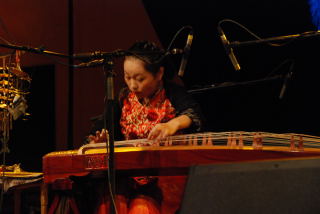
A modern playing technique, influenced by Western music, uses the left hand to provide harmony and bass notes; this gives the guzheng a more flexible musical range, permitting harmonic progression. It has its limitations, preventing the subtle ornamentation provided by the left hand in traditional music. Guzheng students who take the Central Conservatory of Music examinations are required to learn traditional and modern pieces.
Notable 20th-century players and teachers include Wang Xunzhi (王巽之, 1899–1972), who popularized the Wulin zheng school based in Hangzhou, Zhejiang; Lou Shuhua, who rearranged a traditional guzheng piece and named it Yu Zhou Chang Wan; Liang Tsai-Ping (1911–2000), who edited the first guzheng manual (Nizheng Pu) in 1938; Cao Dongfu (1898–1970), from Henan; Gao Zicheng (born 1918) and Zhao Yuzhai (born 1924), both from Shandong; Su Wenxian (1907–1971); Guo Ying (born 1914) and Lin Maogen (born 1929), both from Chaozhou; the Hakka Luo Jiuxiang (1902–1978) and Cao Guifen and Cao Zheng (曹正, 1920–1998), both of whom trained in the Henan school. The Cao family of Henan are known as masters of the guzheng.
Notable 21st-century Chinese guzheng players include Xiang Sihua, Wang Zhongshan, Yuan Sha, Chang Jing and Funa. Although most guzheng music is Chinese classical music, the American composer Lou Harrison (1917–2003) played and composed for the instrument. Contemporary guzheng works have also been written by the non-Chinese composers Halim El-Dabh, Kevin Austin, David Vayo, Simon Steen-Andersen, and Jon Foreman.
It was played by Zhang Yan (张燕, 1945–1996), performing and recording with Asian American jazz bandleader Jon Jang. Other musicians playing in non-traditional styles include Wu Fei, Xu Fengxia, Randy Raine-Reusch, Mohamed Faizal, B. Mohamed Salim, Mei Han, Bei Bei He, Zi Lan Liao, Levi Chen, Andreas Vollenweider, Jaron Lanier, Mike Hovancsek, Chih-Lin Chou, Liu Le and David Sait. Koto player Brett Larner developed innovative works for the guzheng and played the instrument in a duet with electronic musician Samm Bennett on his CD, Itadakimasu.
In the television drama series My Fair Princess, actress Ruby Lin's character Xia Ziwei plays the guzheng (although she mimes to the music). It is featured in the 1980 pop hit, "Everybody's Got to Learn Sometime", by the Korgis.

In the film Kung Fu Hustle, the assassins known as The Harpists play a long zither to generate bladed and percussive attacks. The instrument has raised bridges like a guzheng but its body is shaped like a guqin. The sound is that of a guzheng.
The guzheng has been used in rock music by Chinese performer Wang Yong of Cui Jian, the English musician Jakko Jakszyk on the 2011 Jakszyk, Fripp & Collins album A Scarcity of Miracles), J.B. Brubaker of August Burns Red on "Creative Captivity" from the 2013 album, Rescue & Restore, and the virtual band Gorillaz on "Hong Kong" (from the 2005 Help! A Day in the Life compilation). Jerusalem-based multi-instrumentalist Bradley Fish used the guzheng with a rock-influenced style and electronic effects on his 1996 collaboration, "The Aquarium Conspiracy" (with Sugarcubes/Björk drummer Sigtryggur Baldursson), and is the most widely recorded artist of loops for the instrument.
The đàn tranh (Vietnamese: [ɗâːn ʈajŋ̟], 彈箏) or đàn thập lục is a plucked zither of Vietnam, similar to the Chinese guzheng, the Japanese koto, the Korean kayagum and the Mongolia yatga. It has a long soundbox with the steel strings, movable bridges and tuning pegs positioned on its top.
The đàn tranh can be used either as a solo instrument, as part of various instrumental ensembles or to accompany vocal performances.
In the late 13th and early 14th centuries, the đàn tranh had 14 strings. Between the late 15th and the 18th centuries, the number of strings of the đàn tranh increased to fifteen and the instrument was called thập ngũ huyền cầm. In the 19th centuries, the đàn tranh with 16 strings appeared and had become the standard version until the late 1970s and early 1980s.
The Vietnamese dan tranh, like the Japanese koto and Korean gayageum, is ultimately descended from the Chinese guzheng.
The body of the đàn tranh is between 104 and 120 cm in length. The soundbox consists of a curved top plate, a flat bottom plate, and six side-pieces. The top and bottom plates are usually made of Paulownia wood. The side-pieces as well as the bridges, and tuning pegs and the two small legs are made of hard wood. The movable briges have the shape of the letter V turned upside down, and their sizes varies according to their position: The one for the lowest string is the largest. The higher their position, the smaller their size is. The strings are made of steel and have varying diameters. They are tuned to the pentatonic scale. Performers usually wear picks made of metal, plastic, or tortoise-shell to pluck the strings.
The standard version of the đàn tranh, or the đàn thập lục had 16 strings and had been used between the nineteenth century and the late 1980s. In the late 1950s, South Vietnamese master musician and instrumental designer Nguyễn Vĩnh Bảo (b. 1918) began to design and construct instruments with 17, 19 and 21 strings. By the late 1980s, the 17-stringed đàn tranh has become the standard version of the instrument used throughout Vietnam. Larger instruments with 22, 24 and 25 strings have also been made in the 1980s and 1990s.
Performers pluck the strings with the right hand and bend the strings with the left hand to create a wide range of microtonal and tonal ornaments. In traditional music, performers use 2 or 3 fingers (thumb and index, or thumb, index and middle fingers) to pluck the strings. In a number of new compositions, as many as four or five fingers may be used to pluck the strings. In these new works, the left hand may also be used to enable the performer to play two simultaneous parts.

Text is available under the Creative Commons Attribution-ShareAlike License.
Date: June 2019.
Photo Credits:
(1) Zither Player,
(3) Margaret MacArthur,
(4) Laima Jansone ,
(5) Wu Mengmeng,
(7) Tri Nguyen
(unknown/website);
(2) 3.MannTour (by Walkin' Tom);
(6) Chanyuan Zhao (by Tom Kamphans).